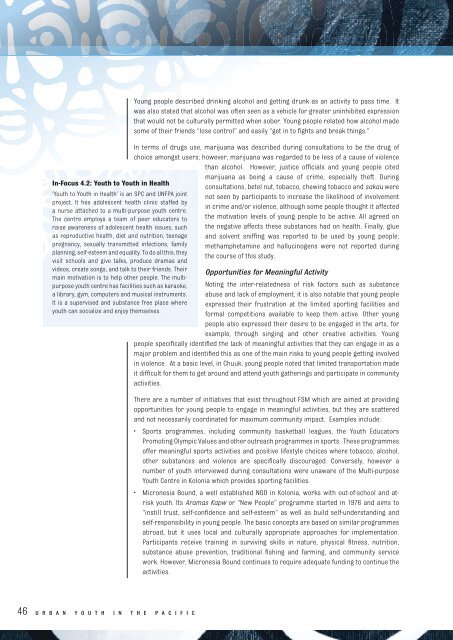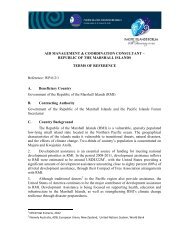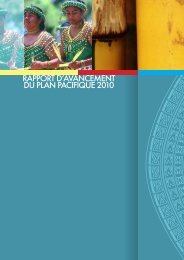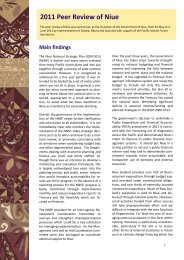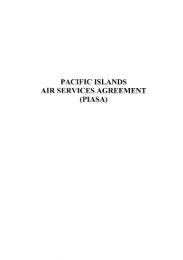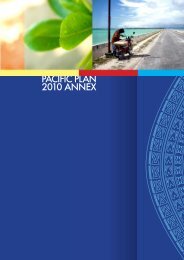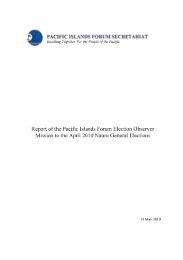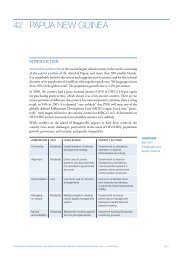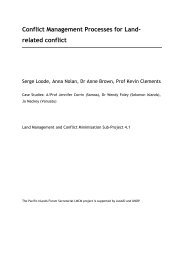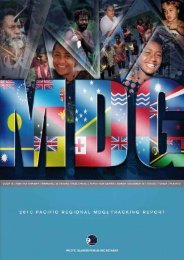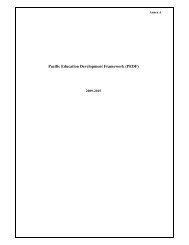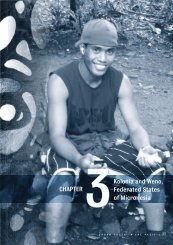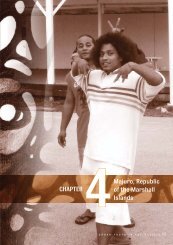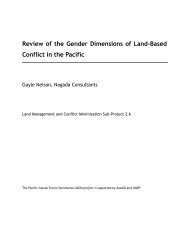Kolonia and Weno, Federated States of Micronesia CHAPTER 3 ...
Kolonia and Weno, Federated States of Micronesia CHAPTER 3 ...
Kolonia and Weno, Federated States of Micronesia CHAPTER 3 ...
Create successful ePaper yourself
Turn your PDF publications into a flip-book with our unique Google optimized e-Paper software.
46<br />
In-Focus 4.2: Youth to Youth in Health<br />
‘Youth to Youth in Health’ is an SPC <strong>and</strong> UNFPA joint<br />
project. It has adolescent health clinic staffed by<br />
a nurse attached to a multi-purpose youth centre.<br />
The centre employs a team <strong>of</strong> peer educators to<br />
raise awareness <strong>of</strong> adolescent health issues, such<br />
as reproductive health, diet <strong>and</strong> nutrition, teenage<br />
pregnancy, sexually transmitted infections, family<br />
planning, self-esteem <strong>and</strong> equality. To do all this, they<br />
visit schools <strong>and</strong> give talks, produce dramas <strong>and</strong><br />
videos, create songs, <strong>and</strong> talk to their friends. Their<br />
main motivation is to help other people. The multipurpose<br />
youth centre has facilities such as karaoke,<br />
a library, gym, computers <strong>and</strong> musical instruments.<br />
It is a supervised <strong>and</strong> substance free place where<br />
youth can socialize <strong>and</strong> enjoy themselves.<br />
U R B A N Y O U T H I N T H E P A C I F I C<br />
Young people described drinking alcohol <strong>and</strong> getting drunk as an activity to pass time. It<br />
was also stated that alcohol was <strong>of</strong>ten seen as a vehicle for greater uninhibited expression<br />
that would not be culturally permitted when sober. Young people related how alcohol made<br />
some <strong>of</strong> their friends “lose control” <strong>and</strong> easily “get in to fights <strong>and</strong> break things.”<br />
In terms <strong>of</strong> drugs use, marijuana was described during consultations to be the drug <strong>of</strong><br />
choice amongst users; however, marijuana was regarded to be less <strong>of</strong> a cause <strong>of</strong> violence<br />
than alcohol. However, justice <strong>of</strong>ficials <strong>and</strong> young people cited<br />
marijuana as being a cause <strong>of</strong> crime, especially theft. During<br />
consultations, betel nut, tobacco, chewing tobacco <strong>and</strong> sakau were<br />
not seen by participants to increase the likelihood <strong>of</strong> involvement<br />
in crime <strong>and</strong>/or violence, although some people thought it affected<br />
the motivation levels <strong>of</strong> young people to be active. All agreed on<br />
the negative affects these substances had on health. Finally, glue<br />
<strong>and</strong> solvent sniffing was reported to be used by young people;<br />
methamphetamine <strong>and</strong> hallucinogens were not reported during<br />
the course <strong>of</strong> this study.<br />
Opportunities for Meaningful Activity<br />
Noting the inter-relatedness <strong>of</strong> risk factors such as substance<br />
abuse <strong>and</strong> lack <strong>of</strong> employment, it is also notable that young people<br />
expressed their frustration at the limited sporting facilities <strong>and</strong><br />
formal competitions available to keep them active. Other young<br />
people also expressed their desire to be engaged in the arts, for<br />
example, through singing <strong>and</strong> other creative activities. Young<br />
people specifically identified the lack <strong>of</strong> meaningful activities that they can engage in as a<br />
major problem <strong>and</strong> identified this as one <strong>of</strong> the main risks to young people getting involved<br />
in violence. At a basic level, in Chuuk, young people noted that limited transportation made<br />
it difficult for them to get around <strong>and</strong> attend youth gatherings <strong>and</strong> participate in community<br />
activities.<br />
There are a number <strong>of</strong> initiatives that exist throughout FSM which are aimed at providing<br />
opportunities for young people to engage in meaningful activities, but they are scattered<br />
<strong>and</strong> not necessarily coordinated for maximum community impact. Examples include:<br />
<br />
Promoting Olympic Values <strong>and</strong> other outreach programmes in sports. These programmes<br />
<strong>of</strong>fer meaningful sports activities <strong>and</strong> positive lifestyle choices where tobacco, alcohol,<br />
other substances <strong>and</strong> violence are specifically discouraged. Conversely, however a<br />
number <strong>of</strong> youth interviewed during consultations were unaware <strong>of</strong> the Multi-purpose<br />
Youth Centre in <strong>Kolonia</strong> which provides sporting facilities.<br />
<br />
risk youth. Its Aramas Kapw or “New People” programme started in 1976 <strong>and</strong> aims to<br />
“instill trust, self-confidence <strong>and</strong> self-esteem” as well as build self-underst<strong>and</strong>ing <strong>and</strong><br />
self-responsibility in young people. The basic concepts are based on similar programmes<br />
abroad, but it uses local <strong>and</strong> culturally appropriate approaches for implementation.<br />
Participants receive training in surviving skills in nature, physical fitness, nutrition,<br />
substance abuse prevention, traditional fishing <strong>and</strong> farming, <strong>and</strong> community service<br />
work. However, <strong>Micronesia</strong> Bound continues to require adequate funding to continue the<br />
activities.


